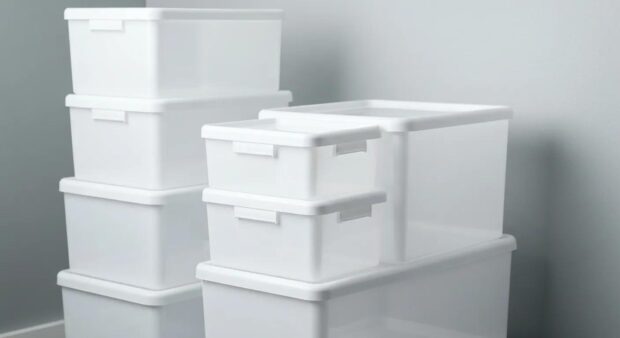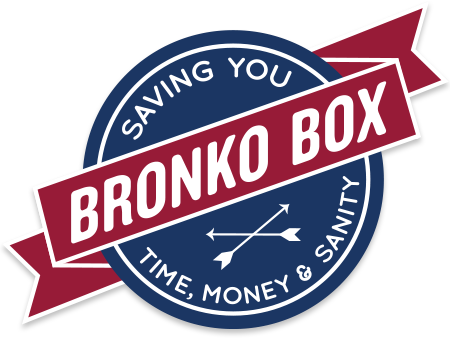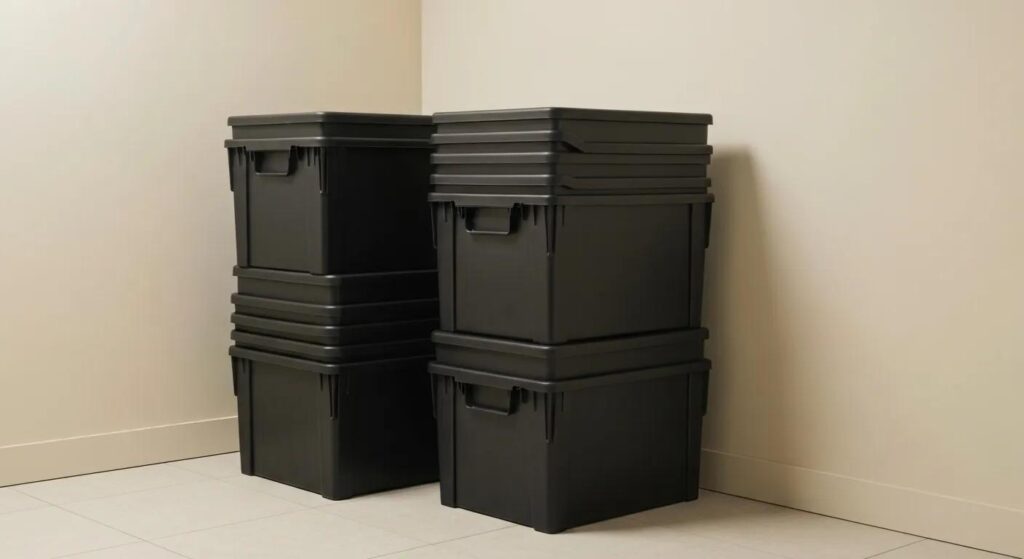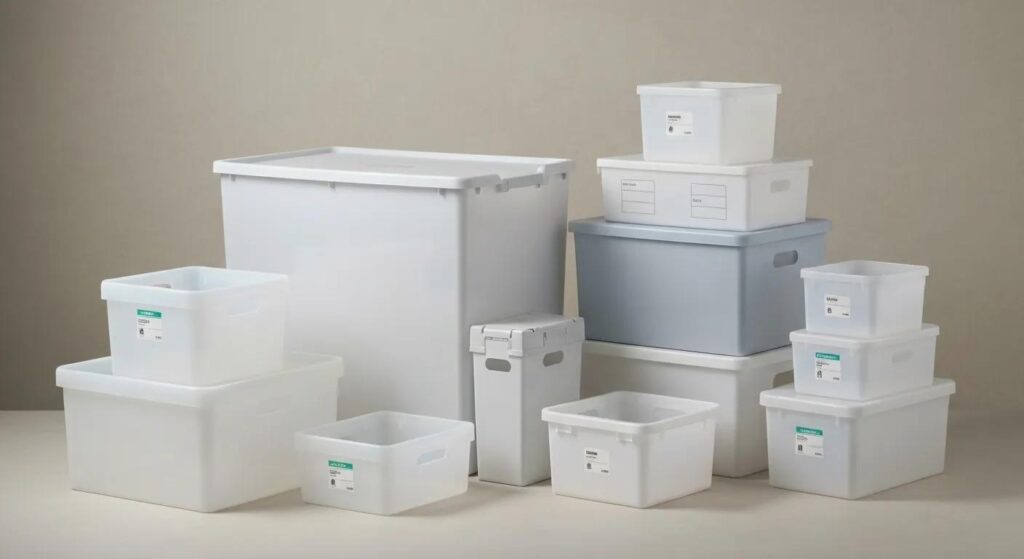
Figuring out the cost of moving boxes for a typical move is a big part of getting ready. Knowing your budget upfront helps you avoid any last-minute surprises. We’ll walk you through what makes boxes cost what they do, how much you might spend based on your home size, and some smart ways to save. You’ll learn how different materials change the price, how buying cardboard stacks up against renting plastic bins, and what other supplies you’ll need. We’ll break down the average costs for moving out of a two- or three-bedroom place, give you an idea of what tape and bubble wrap might cost, and highlight local Austin options like Bronko Box’s green rental kits. With this guide, you can plan your move with confidence, get the best value, and pick the most budget-friendly and eco-conscious packing method.
What Drives the Price of Moving Boxes?
The materials used, the size of the boxes, and how you get them all play a role in the final cost. Each choice affects how tough the box is, its impact on the environment, and what you get for your money.
How Material and Type Affect Moving Box Prices
The stuff boxes are made of dictates their price, based on how they’re made and how long they last. Cardboard boxes are cheaper to start with but end up as waste. Reusable plastic bins cost more to rent but are built to last and can be used again and again.
Before we dive into prices, check out this rundown of common options:
| Box Material | Price Range | Durability Benefit |
|---|---|---|
| Single-wall Cardboard | $1.28–$3.48 per box | Good for lighter items |
| Double-wall Cardboard | $3.09–$5.39 per box | Stronger for heavier loads |
| Reusable Plastic | Varies by rental service | Built for many uses |
| Specialty Wardrobe | Varies by retailer | Keeps hanging clothes neat |
Cardboard is a budget-friendly choice for one-time use, while renting plastic costs more but ensures your belongings are handled with care. Knowing the benefits of each material helps you decide on the right size and number of boxes for your stuff.
How Box Size and Quantity Impact Your Total Moving Box Costs
Picking the right box sizes and the right number of them helps you save money by not over- or under-packing. Small boxes are great for books and cost about $1.28–$3.48 each. Medium boxes for kitchen items are $3.09–$5.39, and large boxes for bedding are also around $3.09–$5.39.
Keep these in mind:
- How many delicate items you have that need smaller, more protective boxes
- Bulky items that require bigger cartons
- Potential savings when you buy kits or bundles
Using a simple calculator to estimate how many boxes you’ll need means you won’t waste money on unused boxes or run out when you need them most. Getting the quantity right prevents both budget blowouts and packing delays.
Should You Buy, Rent, or Use Used Moving Boxes?
Whether you buy new, rent, or find used boxes depends on your budget, your commitment to the environment, and what’s easiest for you. Buying new cardboard boxes means you own them right away but creates waste. Renting reusable plastic bins is better for the planet and makes moving simpler, but it comes with rental fees for each move. Grabbing used boxes saves money upfront but can mean dealing with boxes that aren’t in great shape or aren’t very clean.
Here’s a quick look at the pros and cons:
- New Cardboard: Cheapest per box; needs to be thrown away
- Plastic Rental: Top-notch durability; includes delivery and pickup
- Used Boxes: Very low cost; availability can be hit or miss
Weighing the initial cost against long-term savings and your environmental goals will help you choose the best way to get your moving boxes.
Average Moving Box Costs by Home Size
How Much Do Moving Boxes Cost for a 2-Bedroom Apartment?
For a typical two-bedroom apartment, you’ll likely need around 40–50 boxes. This could cost between $80–$150 for new cardboard boxes or $120–$200 for renting reusable plastic bins. Moving kits often include a mix of small, medium, large, and wardrobe boxes to handle everything from clothes to kitchenware and books.
- Cardboard Kit Estimate: 10 small, 20 medium, 15 large boxes
- Plastic Rental Kit Estimate: Similar mix, with delivery and pickup included
These numbers give you a realistic idea of what to expect when planning your moving budget and comparing different kit options.
What Is the Average Cost of Moving Boxes for a 3-Bedroom House?
Moving a three-bedroom home usually means you’ll need about 60–75 boxes. This translates to $120–$225 for cardboard boxes or $180–$300 for reusable bins. Buying complete kits can often bring down the per-box cost by as much as 20 percent.
- Sample Cardboard Package: 15 small, 25 medium, 25 large, 10 wardrobe boxes
- Sample Rental Package: A full plastic kit, often including dollies and labels
These estimates help you budget accurately for larger homes and avoid unexpected packing expenses.
How Many Boxes Do You Need for Different Home Sizes?
Estimating the number of boxes you’ll need based on your home size makes budgeting easier for moves of all scales.
| Home Size | Estimated Boxes | Average Cost Range |
|---|---|---|
| Studio | 20–25 | $40–$75 |
| One-Bedroom | 30–40 | $60–$120 |
| Two-Bedroom | 40–50 | $80–$200 |
| Three-Bedroom | 60–75 | $120–$300 |
Knowing how many boxes you’ll need ahead of time helps you get a clearer picture of costs and choose the right kits for your specific home size.
How Much Should You Budget for Additional Packing Supplies?
What Are the Typical Costs of Tape, Bubble Wrap, and Packing Paper?
Essential packing supplies generally have predictable price points:
- Packing Tape: $3–$5 per roll
- Bubble Wrap: $10–$15 per roll
- Packing Paper: $15–$25 per bulk pack
- Labels and Markers: $5–$10 total
For a medium-sized move, plan to spend around $50–$100 on these items to make sure everything is packed securely and clearly labeled.
How Do Packing Supply Costs Vary by Move Size and Fragility?
Larger homes and more fragile items mean you’ll need more cushioning and specialized materials.
- Small Moves: Standard tape and paper are usually enough, costing $50–$75
- Medium Moves: You might need extra bubble wrap and foam inserts, budgeting $75–$125
- Large Moves: Consider extra protective kits and box liners, with costs ranging from $125–$200
Adjusting your supply budget based on how much you’re moving and how delicate your belongings are will help you allocate funds wisely for protective accessories.
Renting Reusable Plastic Moving Boxes vs. Buying Cardboard Boxes
What Are the Cost Benefits of Renting Plastic Moving Boxes?
Renting reusable boxes often saves you money when you factor in package deals, free delivery, and pickup services. For a standard two-bedroom move, renting plastic bins might cost around $150–$180, compared to $100–$150 for buying cardboard. However, rental kits offer great value because they’re durable and can be used multiple times, avoiding the need to buy new boxes for every move.
These savings add up over time, making rentals a smart investment for both convenience and long-term budget management.
How Do Environmental and Convenience Factors Affect Cost-Effectiveness?
Using reusable plastic boxes means no cardboard waste and no disposal fees, cutting down on hidden environmental costs. Plus, delivery and pickup services save you the time you’d otherwise spend hunting for and getting rid of packing materials. This smoother process saves you labor and lowers your overall moving effort, making it more cost-effective than just looking at the price per box.
Where Can You Find Affordable Moving Box Rentals and Purchases in Austin?
In Austin, you can find competitive rental rates and cardboard box deals from local providers, major home improvement stores, and specialty suppliers. Some rental services offer subscription-style plans, delivering kits right to your door and picking them up after your move. Retail stores sell discounted cardboard box bundles. Comparing both options will help you find the most cost-effective and convenient solution for your move in the area.
Smart Strategies to Save Money on Moving Boxes and Supplies
How Can Efficient Packing Reduce the Number of Boxes Needed?
Packing smarter, like folding clothes efficiently, vacuum-sealing bulky textiles, and grouping small items together in larger containers, can reduce the overall volume you need to pack. Filling empty spaces with packing paper also means you won’t need as many boxes. These techniques cut down on the total number of boxes required, which directly lowers your material costs and makes the whole process simpler.
Where to Find Free or Discounted Moving Boxes Locally?
You can often find free surplus cardboard boxes from community marketplaces, grocery stores, bookstores, and other retail outlets. Local recycling centers and social media groups sometimes announce free box giveaways, especially around busy moving times. Using these resources can help you avoid paying for boxes altogether, as long as the quality meets your needs.
Why Is Renting Moving Boxes a Cost-Effective and Eco-Friendly Choice?
Renting plastic boxes offers a win-win: you save money over time because they can be used again and again, and you’re being kind to the environment by cutting down on single-use waste. The convenience of delivery and pickup saves you time and effort, and their sturdy design helps prevent damage and avoids replacement costs. This combined approach supports both your budget and your environmental values for any relocation.
How Bronko Box Provides Local Moving Box Solutions in Austin
What Residential Moving Box Kits and Pricing Does Bronko Box Offer?
Bronko Box has different kits available for studio apartments up to three-bedroom homes. Each kit includes small, medium, large bins, and wardrobe boxes. Here’s a look at their pricing:
- Studio Kit: 20 bins and 1 wardrobe box for $120
- Two-Bedroom Kit: 50 bins and 2 wardrobe boxes for $180
- Three-Bedroom Kit: 75 bins and 3 wardrobe boxes for $240
How Does the Bronko Box Rental Service Work in Austin?
The rental process is straightforward and involves four simple steps:
- Choose a kit that fits your home size and the items you’re moving.
- Schedule a delivery of your assembled bins and labels right to your door.
- Pack your belongings securely inside the bins, using any provided cushioning.
- Request a pickup once you’ve finished moving.
Flexible rental periods and included pickup make the entire packing and unpacking process smooth and hassle-free, with no hidden charges.
What Are Customer Experiences and Testimonials for Bronko Box in Austin?
Customers in Austin rave about Bronko Box for saving them time, the durability of their boxes, and how easy the drop-off service is. One happy customer mentioned that not having to deal with cardboard disposal saved them two hours after the move. Another highlighted that they had zero damage claims thanks to the strong plastic construction. These reviews show a high level of trust, consistent quality, and strong local appeal for Austin movers.
Key Takeaways for Budgeting Your Moving Box Costs
How to Plan Your Moving Box Budget Effectively?
Start by figuring out your home size and what you need to pack. Then, decide on the best way to get your boxes—new, used, or rental—based on how durable you need them to be and your environmental goals. Estimate the number of boxes you’ll need, add in costs for tape and cushioning, and compare kit prices with per-unit costs to create a precise budget that covers all your packing needs.
Why Choose Reusable Moving Boxes for Cost and Environmental Benefits?
Reusable plastic bins offer long-term savings because they can be used multiple times, and they’re better for the environment by reducing waste. Delivery and pickup services eliminate the hassle of finding and disposing of packing materials, while their strong build ensures your items are transported safely. This combination of affordability and eco-friendliness makes reusable rentals the top choice for smart, budget-conscious movers.
The cost of moving boxes is one of the most manageable expenses when relocating. By picking the right materials, getting the right sizes, and using convenient rental options like Bronko Box, you can optimize your moving budget, lessen your environmental impact, and enjoy a smoother packing experience that fits your home size and schedule. Plan carefully, compare your options, and use smart packing techniques to make your next move both financially sound and logistically easy.
Filed under: moving boxes


